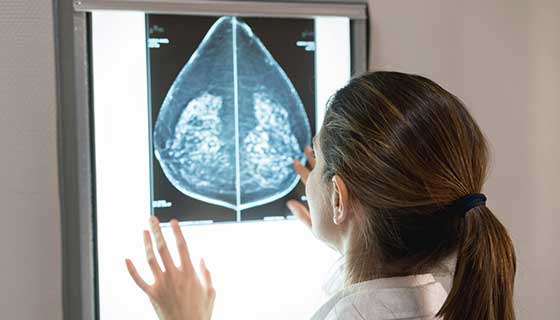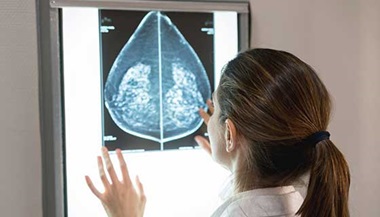Abdominal Ultrasound
What is an abdominal ultrasound?
An abdominal ultrasound is a noninvasive procedure used to assess the organs and structures within the abdomen. This includes the liver, gallbladder, pancreas, bile ducts, spleen, and abdominal aorta. Ultrasound technology allows quick visualization of the abdominal organs and structures from outside the body. Ultrasound may also be used to assess blood flow to abdominal organs.
Ultrasound uses a transducer that sends out ultrasound waves at a frequency too high to be heard. The ultrasound transducer is placed on the skin, and the ultrasound waves move through the body to the organs and structures within. The sound waves bounce off the organs like an echo and return to the transducer. The transducer processes the reflected waves, which are then converted by a computer into an image of the organs or tissues being examined.
The sound waves travel at different speeds depending on the type of tissue encountered - fastest through bone tissue and slowest through air. The speed at which the sound waves are returned to the transducer, as well as how much of the sound wave returns, is translated by the transducer as different types of tissue.
An ultrasound gel is placed on the transducer and the skin to allow for smooth movement of the transducer over the skin and to eliminate air between the skin and the transducer for the best sound conduction.
Another type of ultrasound is Doppler ultrasound, sometimes called a duplex study, used to show the speed and direction of blood flow within the abdomen. Unlike a standard ultrasound, some sound waves during the Doppler exam are audible.
Ultrasound may be safely used during pregnancy or in the presence of allergies to contrast dye, because no radiation or contrast dyes are used.
Other related procedures that may be performed to evaluate the abdomen include abdominal X-rays, computed tomography (CT scan) of the abdomen, and abdominal angiogram.
Why might I need an abdominal ultrasound?
Abdominal ultrasound may be used to assess the size and location of abdominal organs and structures. It can also be used to check the abdomen for conditions such as:
-
Cysts
-
Tumors
-
Collection of pus (abscesses)
-
Obstructions
-
Fluid collection
-
Blockages (clots) in blood vessels
-
Infection
The size of the abdominal aorta can be measured by ultrasound in order to detect an aortic aneurysm. Stones in the gallbladder, kidneys, and ureters may be detected by ultrasound.
Abdominal ultrasound may be performed to assist in placement of needles used to biopsy abdominal tissue or to drain fluid from a cyst or abscess.
Abdominal ultrasound may also be used to assess the blood flow of various structures within the abdomen.
There may be other reasons for your doctor to recommend an abdominal ultrasound.
What are the risks of abdominal ultrasound?
There is no radiation used and generally no discomfort from the application of the ultrasound transducer to the skin.
There may be risks depending on your specific medical condition. Be sure to discuss any concerns with your doctor prior to the procedure.
Certain factors or conditions may interfere with the results of the test. These include:
-
Severe obesity
-
Barium within the intestines from a recent barium procedure
How do I prepare for an abdominal ultrasound?
EAT/DRINK: For an A.M. appointment, fat free dinner the evening before. Nothing to eat or drink from midnight until after the examination. For a P.M. appointment, clear liquid breakfast (no milk) before 9 A.M. Nothing to eat or drink after breakfast.
MEDICATIONS: You may take your medications with a small amount of water.
Based on your medical condition, your doctor may request other specific preparation.
What happens during an abdominal ultrasound?
An abdominal ultrasound may be done as an outpatient or as part of your stay in a hospital. Although each facility may have different protocols in place, generally an ultrasound procedure follows this process:
-
You will be asked to remove any clothing, jewelry, or other objects that may interfere with the scan.
-
If asked to remove clothing, you will be given a gown to wear.
-
You will lie on an examination table on your back or side, depending on the specific area of the abdomen to be examined.
-
Ultrasound gel is placed on the area of the body that will undergo the ultrasound examination.
-
Using a transducer, a device that sends out the ultrasound waves, the ultrasound wave will be sent through the patient's body.
-
The sound will be reflected off structures inside the body, and the ultrasound machine will analyze the information from the sound waves.
-
The ultrasound machine will create an image of these structures on a monitor. These images will be stored digitally.
There are no confirmed adverse biological effects on patients or instrument operators caused by exposures to ultrasound at the intensity levels used in diagnostic ultrasound.
While the abdominal ultrasound procedure itself causes no pain, having to lie still for the length of the procedure may cause slight discomfort, and the clear gel will feel cool and wet. The technologist will use all possible comfort measures and complete the procedure as quickly as possible to minimize any discomfort.
What happens after an abdominal ultrasound?
There is no special care required after an abdominal ultrasound. You may resume your usual diet and activities unless your doctor advises you differently. Your doctor may give you additional or alternate instructions after the procedure, depending on your particular situation.




.png?h=200&iar=0&mh=260&mw=380&w=200&hash=C21172FD59C4A8F43A151FE21D69D12E)
